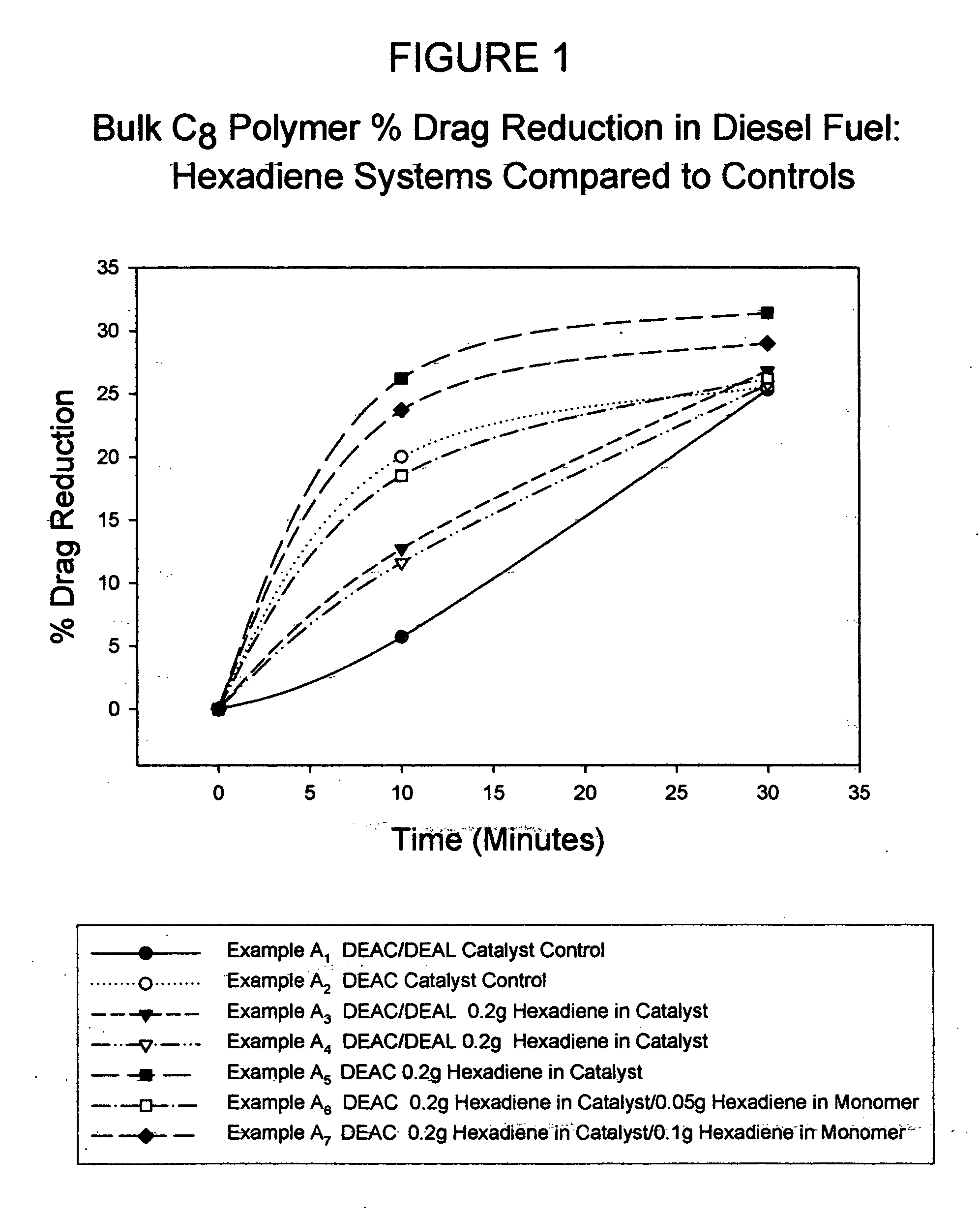Manipulation of topological characteristics of bulk polymerized poly(alpha-olefins) via reaction variables and conditions to enhance dissolution of drag reducing polymers
a polymerization process and topological characteristic technology, applied in the field of polymerization process for producing and using polymeric drag reducing agents, can solve the problems of reducing the drag reducing efficiency of the polymer, unable to place the pao in the hydrocarbon, and drag reducing gels also require special injection equipment, so as to achieve the effect of increasing the resistance to fluid shearing forces
- Summary
- Abstract
- Description
- Claims
- Application Information
AI Technical Summary
Benefits of technology
Problems solved by technology
Method used
Image
Examples
example 1
[0037] Preliminary polymerization experiments were conducted in sealable culture tubes submerged in a cold bath. Thus, in each case known quantities of monomer and or di-functional monomer were deposited in a culture tube, the tube sealed and subsequently purged with nitrogen. Upon cooling the tubes and monomer to 25° F. (−3.9° C.), both aluminum alkyl and titanium trichloride (dispersed in mineral oil) were injected into each tube via syringe. Stirring was accomplished by Teflon® coated magnetic stirring bars in the bottom of the tubes. Once the catalyst-activated monomer reached sufficient viscosity such that the stir bar was prohibited from stirring, the tubes were transferred to a refrigerator freezer where polymerization continued for 24 hours. Upon recovery the bulk polymers were granulated and ground to fine particle sizes utilizing a laboratory colloid mill. Dissolution studies were conducted on each polymer and that data can be found in Table I.
[0038] Shown in FIG. 1 is a ...
example 2
[0042] A manufacturing batch of solution polymerized FLO® XLec was produced as an experimental batch in a 6000 gallon reactor. Instead of utilizing the nominal 14% monomer concentration in the reaction, the reactor was charged with 21% monomer. The resulting FLO® XLec was of higher quality or higher drag reduction value vs. the commercial FLO® XLec and was expected to outperform the typical commercial FLO® XLec. However, subsequent field tests revealed poorer performing dissolution characteristics as compared to traditional solution FLO® XLec. It is believed that when monomer concentrations are increased to larger values (18-24%), the beta-hydride elimination or branching mechanism decreases. Thus, polymer molecular weight and linearity increases and solubility decreases.
example 3
[0043] A reactor combination consisting of a 2 gallon (7.6 liter) continuously stirred tank reactor (CSTR) and a 2″ (5 cm) diameter “Shell and Tube” (S&T) static reactor was used to prepare a number of neat or bulk polymers under standard conditions. Thus, a monomer mixture composed of hexene and dodecene at a known ratio weight ratio (400 grams) was charged into the CSTR and allowed to cool to 25° C. Upon reaching 25° C., a previously prepared catalyst mixture consisting of 0.04 gram 1,5-hexadiene, 0.15 gram of titanium trichloride, 2 grams of aluminum alkyl and 20 grams of mineral oil (Drakeol 34 available from Penreco), was charged to the stirring reactor. This catalyzed mixture was allowed to stir for 5 minutes prior to charging via nitrogen pressure to the static S&T reactor. The mixture was subsequently allowed to polymerize for 24 hours in the S&T reactor at a constantly cooled temperature of 30° C. Upon reaction completion, the solid polymer was collected, granulated via War...
PUM
| Property | Measurement | Unit |
|---|---|---|
| temperature | aaaaa | aaaaa |
| temperature | aaaaa | aaaaa |
| temperature | aaaaa | aaaaa |
Abstract
Description
Claims
Application Information
 Login to View More
Login to View More - R&D
- Intellectual Property
- Life Sciences
- Materials
- Tech Scout
- Unparalleled Data Quality
- Higher Quality Content
- 60% Fewer Hallucinations
Browse by: Latest US Patents, China's latest patents, Technical Efficacy Thesaurus, Application Domain, Technology Topic, Popular Technical Reports.
© 2025 PatSnap. All rights reserved.Legal|Privacy policy|Modern Slavery Act Transparency Statement|Sitemap|About US| Contact US: help@patsnap.com



